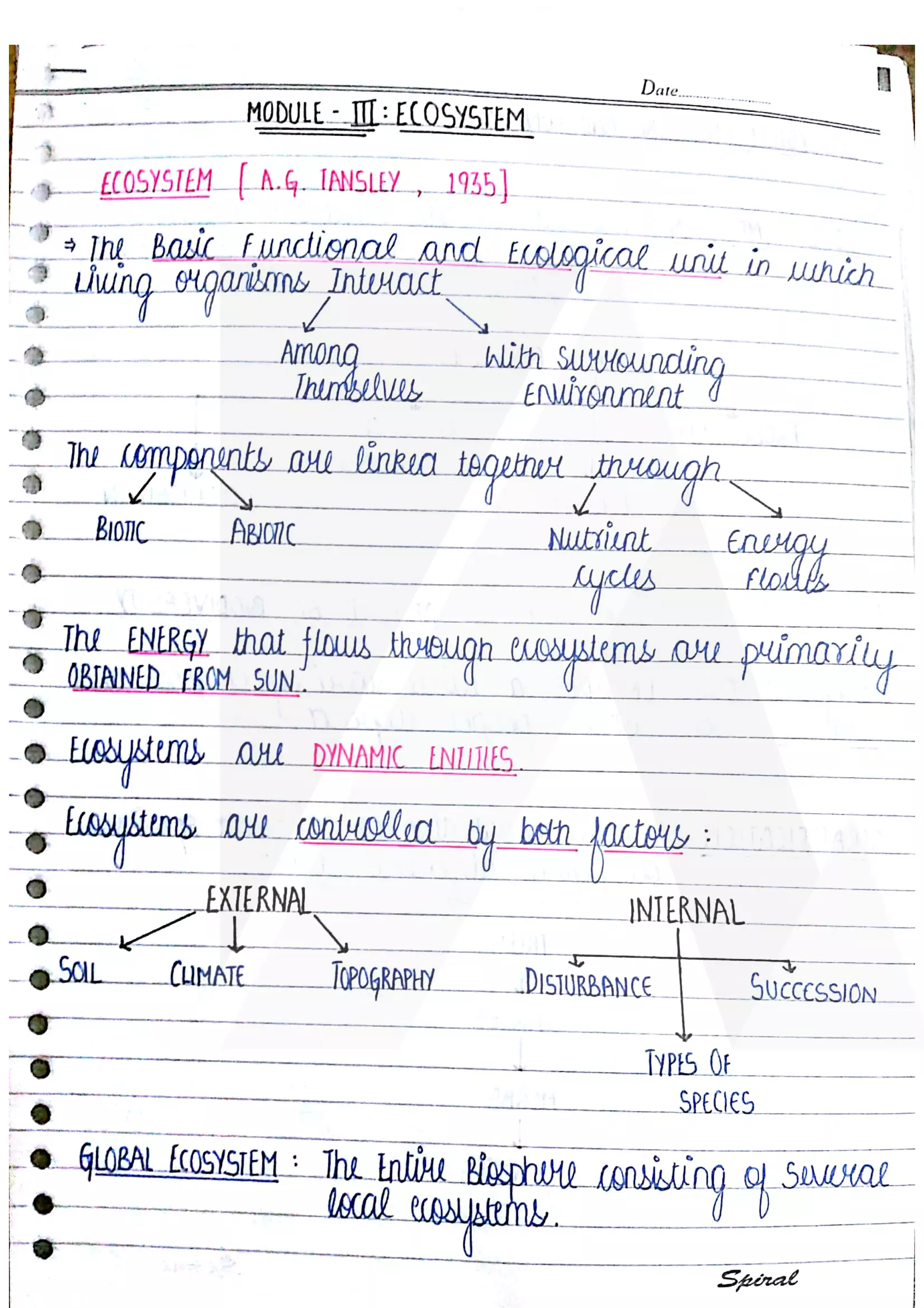Ecosystems BCA Notes
Ecosystems BCA Notes: This article contains BCA Environmental Studies Subject Unit 3 Ecosystems BCA Notes. this is very helpful for BCA students. please share this article with your all friends and all groups. and all notes are available on this website.
Quick Links:
Understanding ecosystems is crucial within the context of a Bachelor of Computer Applications (BCA) program as it provides insights into the interconnections between natural systems, human activities, and technological advancements. Ecosystems are fundamental units of ecology, encompassing communities of organisms and their interactions with the environment. In this exploration, we’ll delve into the concept of ecosystems, their components, functions, threats, and the role of technology in ecosystem management and conservation.
What is an Ecosystem?
An ecosystem is a complex biological community of interacting organisms (plants, animals, and microorganisms) and their physical environment (air, water, soil) within a specific area. Ecosystems can range from small-scale habitats like ponds or forests to large-scale biomes such as deserts or coral reefs. Key characteristics of ecosystems include:
- Biological Diversity: The variety of species and genetic diversity within an ecosystem.
- Energy Flow: Transfer of energy through food chains and webs, from producers (plants) to consumers (animals) and decomposers (fungi, bacteria).
- Nutrient Cycling: Recycling of nutrients (carbon, nitrogen, phosphorus) through biological and geological processes.
Components of Ecosystems
- Abiotic Factors: Non-living components that influence ecosystem dynamics, including temperature, sunlight, soil composition, and water availability.
- Biotic Factors: Living organisms within the ecosystem, categorized into:
- Producers: Plants and other photosynthetic organisms that convert sunlight into energy through photosynthesis.
- Consumers: Organisms that feed on other organisms for energy, including herbivores (plant-eaters), carnivores (meat-eaters), and omnivores (plant and meat-eaters).
- Decomposers: Organisms like bacteria and fungi that break down organic matter and recycle nutrients back into the ecosystem.
Functions of Ecosystems
Ecosystems provide a range of ecological services essential for human well-being and the functioning of the planet:
- Regulation of Climate: Forests and oceans regulate global climate patterns through carbon sequestration and atmospheric moisture regulation.
- Pollution Control: Wetlands and mangroves filter pollutants from water and air, improving water quality and air purity.
- Support for Agriculture: Ecosystems provide pollination services, pest control, and nutrient cycling that support agricultural productivity.
- Cultural and Aesthetic Value: Ecosystems contribute to cultural heritage, recreation, and aesthetic enjoyment (e.g., national parks, ecotourism).
Threats to Ecosystems
Ecosystems face numerous threats due to human activities, climate change, habitat destruction, pollution, and invasive species. Key threats include:
- Habitat Loss and Fragmentation: Deforestation, urbanization, and land conversion for agriculture reduce habitat availability for wildlife.
- Climate Change: Rising temperatures, altered precipitation patterns, and extreme weather events disrupt ecosystem dynamics and threaten species survival.
- Pollution: Air, water, and soil pollution from industrial activities, agriculture, and urban runoff degrade ecosystem health and biodiversity.
- Over-exploitation: Unsustainable harvesting of natural resources (e.g., overfishing, illegal wildlife trade) depletes populations and disrupts ecosystem balance.
Role of Technology in Ecosystems and BCA
Technology plays a crucial role in understanding, monitoring, and managing ecosystems, integrating data-driven approaches with ecological science. In a BCA program, students can explore how technology contributes to ecosystem management and conservation:
- Remote Sensing and GIS:
- Satellite Imagery: Monitoring land cover changes, deforestation rates, and urban expansion to assess ecosystem health and biodiversity loss.
- Geographic Information Systems (GIS): Mapping and spatial analysis of ecological data to identify conservation priorities, habitat connectivity, and ecosystem services.
- Environmental Monitoring and Data Analytics:
- Sensor Networks: Deploying IoT devices for real-time monitoring of environmental parameters (e.g., water quality, air pollution levels) to detect ecosystem disturbances.
- Big Data Analytics: Analyzing large datasets to model ecosystem dynamics, predict species distributions, and assess the impacts of human activities on ecosystems.
- Simulation and Modeling:
- Developing computational models to simulate ecosystem processes (e.g., nutrient cycling, species interactions) and predict the consequences of environmental change.
- Conservation Technology and Citizen Science:
- Conservation Apps: Engaging the public in biodiversity monitoring and conservation efforts through mobile apps that allow users to report wildlife sightings, invasive species, or habitat destruction.
- Environmental DNA (eDNA): Using genetic techniques to detect species presence in aquatic and terrestrial environments, aiding in biodiversity assessment and monitoring efforts.
Applications and Case Studies
- Case Study: Coral Reef Conservation:
- Using remote sensing to monitor coral bleaching events, temperature anomalies, and habitat degradation in coral reef ecosystems.
- Implementing marine protected areas and sustainable fishing practices based on GIS analysis of reef health and fish populations.
- Case Study: Forest Management:
- Employing UAVs (drones) and LiDAR technology for forest inventory, monitoring tree health, and detecting illegal logging activities.
- Developing forest management plans that balance timber extraction with biodiversity conservation using spatial analysis tools.
- Case Study: Urban Ecosystems:
- Designing green infrastructure and urban planning strategies using GIS to enhance biodiversity, mitigate urban heat islands, and improve air quality.
- Engaging communities in urban greening projects through citizen science initiatives and digital platforms promoting sustainable urban living.
Career Opportunities in Ecosystem Informatics
BCA graduates interested in ecosystems and conservation can pursue diverse career paths:
- Environmental Data Analyst: Analyzing ecological datasets, conducting spatial analysis, and modeling ecosystem dynamics for conservation planning.
- GIS Specialist: Using GIS software for mapping, monitoring, and spatial analysis of biodiversity, habitat fragmentation, and ecosystem services.
- Conservation Technologist: Developing software applications, IoT solutions, and data-driven tools for ecosystem monitoring, wildlife tracking, and habitat restoration.
- Environmental Policy Analyst: Providing technical expertise in environmental policy development, environmental impact assessments, and natural resource management.
Ecosystems BCA Notes

|
|
|||